Gateway FX530: Mad Cows and Quad Core Overclocking
by Jarred Walton on February 9, 2007 12:01 AM EST- Posted in
- Systems
Internals and Design
Removing the side panel to get at the interior is quite simple and takes only seconds. With the side out of the way we get our first look at the interior. Everything is relatively tidy, but the wiring standards certainly aren't up to the quality of the elite system builders. Most of the cables are left hanging, but they do not directly block any of the fans so airflow isn't impeded. That's the most important thing when looking at the internals of a case, especially when it comes to a case that holds an overclocked quad core processor.
Some of the cables could be talked out of the way better, but having clean cables is something of a Catch-22. Having all of the cables tucked out of the way makes things look clean, but the flip side is that if you ever have to do any work on the interior of the PC, all of the tucked away cables are much more likely to cause problems than help out. If you ever have to change out components, nice wiring jobs where everything is zip-tied out of the way can be a real pain to deal with. Given that the Gateway FX530 doesn't have any windows on the side panels, having an exquisite wiring job really isn't necessary.
Gateway could have done a better job, but given the choice between better wiring and a lower price tag, we would typically opt for the cost savings and clean up the cabling ourselves if it ever presents a problem. In a sense the wiring job is a good representation of the system as a whole. It's functional and will get the job done, but it's not going to win any style awards. Some people are interested in getting an exotic PC that will stand out from the crowd, and they are interested in outward appearances rather than the bottom-line performance. The Gateway FX530 eschews form and style and focuses predominantly on functionality.
We mentioned the weight of the system earlier, and after looking at the interior you can start to get an idea of where some of the weight comes from. The two graphics cards along with the CPU heatsink are all pretty large, and additional weight is added in the form of two support bars that help to hold the graphics cards in place. The support bars do make removing your graphics cards - or any other expansion card for that matter - a bit more difficult, but they also contribute to the overall sturdiness of the case.
At the bottom-front of the case are the three internal hard drive bays. The hard drives slide into place and are then secured by the sliding green latch on the side. This makes installing or removing hard drives simple, although the GPU support bars do make reaching the green lever a bit less convenient. Also, the hard drives tend to fit extremely snugly, so removing them does require more effort than we at first expected. Similarly, the optical drives have a latching mechanism that makes it easier to add or remove drives. Besides the latching mechanism, however, a single thumbscrew is also used to help secure each optical drive. Below the optical drives, it is possible to install a fourth hard drive above the flash memory reader, although there is less ventilation to this area and more cable clutter so it's more difficult to gain access. We would also be hesitant to install some of the warmer HDDs like the Raptors or the 750GB Seagate in such a tight space, as long-term reliability might be compromised.
You can also see in the above picture that the plastic shroud that helps direct ventilation over the CPU heatsink can be removed. Behind the shroud is a large 120mm variable speed fan. When the system is idle, it's pretty quiet all things considered. Once you start to run a few CPU intensive applications, however, the temperature controlled fans rapidly begin to speed up and make more noise.
Helping out the front fan is a second 120mm fan at the rear of the system. Again, this reminds us of the Dell XPS 410 design, only with more processing power available. The two fans help to create a nice wind tunnel effect over the CPU and chipset area, keeping the system relatively cool without generating a whole lot of noise.
With all of the powerful components present in the system, it's not too surprising to find a large 700W power supply feeding the beast. The power supply is manufactured by Delta Electronics, a brand that is present in many OEM desktop and laptop systems. The quality may or may not be up to the level of some of the enthusiast power supplies, but in testing we did not encounter any difficulties. The PSU has four separate 12V lines, with a combined output not to exceed 50A. Likewise, the total output on the 3.3V and 5V lines is not to exceed 140W. The power supply is rated to handle a continuous load of 700W, however, which is far more than the tested configuration is able to use.
Returning to the GPUs, we have removed the support bars to get a better look. With the two large X1950 graphics cards, the TV tuner, and an X-Fi soundcard, the expansion slot area is fully utilized and somewhat cramped. It's interesting to look at the two X1950 GPUs, specifically their heatsinks, as they appear to be specially designed to fit within the system. The top CrossFire card has a heatsink and fan design that blows inward, which allows it to fit next to the large CPU heatsink. Meanwhile, the bottom X1950 XTX is a standard ATI design that vents out the rear of the case. It's also worth noting that the top GPU occupies two slot widths, but it only takes up a single expansion slot bracket, which as we mentioned earlier is part of the reason why a GeForce 8800 GPU can't fit in the top slot. However, even if there were a second expansion bracket mount open, the size of the heatsink on a GeForce 8800 would preclude it from being used, unless similar to the X1950 CrossFire card it was a special design.
We took a comparison shot of the two graphics cards alongside an 8800 GTX to give you a better idea of how the CrossFire card has been specifically designed for use in the FX530. You can also see how much larger the 8800 GTX is, and at first we weren't even sure if it would be able to fit within the system at all. With a bit of careful maneuvering, however, we did manage to fit it into the bottom X16 slot. There's not a whole lot of extra room, and the support bars can no longer be used given the location of the PCI-E power connectors. The power supply's PCI-E connectors are also a stretch to get both of them to reach the bottom graphics slot, but we did manage to make it work.
We will take a look at performance of the Gateway system with the 8800 GTX installed, along with the included X1950 CrossFire solution. In general, however, even though the CrossFire cards are faster in many situations we would prefer to have a single 8800 GTX instead of two X1950 cards in a CrossFire solution. The launch of Windows Vista has only solidified that recommendation, as both CrossFire and SLI are experiencing difficulties with the new WDDM. There have also been numerous instances since the first appearance of SLI and CrossFire where newer gaming titles weren't able to properly utilize both GPUs. Combine that with the fact that a single 8800 GTX cost less than an X1950 CrossFire solution and it includes DirectX 10 support, and out of the gate the FX530 appears to be a design in need of a graphics upgrade, at least if you're really like playing modern 3D games.
Removing the side panel to get at the interior is quite simple and takes only seconds. With the side out of the way we get our first look at the interior. Everything is relatively tidy, but the wiring standards certainly aren't up to the quality of the elite system builders. Most of the cables are left hanging, but they do not directly block any of the fans so airflow isn't impeded. That's the most important thing when looking at the internals of a case, especially when it comes to a case that holds an overclocked quad core processor.
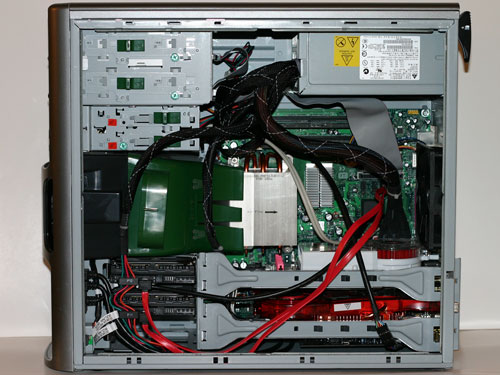 |
| Click to enlarge |
Some of the cables could be talked out of the way better, but having clean cables is something of a Catch-22. Having all of the cables tucked out of the way makes things look clean, but the flip side is that if you ever have to do any work on the interior of the PC, all of the tucked away cables are much more likely to cause problems than help out. If you ever have to change out components, nice wiring jobs where everything is zip-tied out of the way can be a real pain to deal with. Given that the Gateway FX530 doesn't have any windows on the side panels, having an exquisite wiring job really isn't necessary.
Gateway could have done a better job, but given the choice between better wiring and a lower price tag, we would typically opt for the cost savings and clean up the cabling ourselves if it ever presents a problem. In a sense the wiring job is a good representation of the system as a whole. It's functional and will get the job done, but it's not going to win any style awards. Some people are interested in getting an exotic PC that will stand out from the crowd, and they are interested in outward appearances rather than the bottom-line performance. The Gateway FX530 eschews form and style and focuses predominantly on functionality.
We mentioned the weight of the system earlier, and after looking at the interior you can start to get an idea of where some of the weight comes from. The two graphics cards along with the CPU heatsink are all pretty large, and additional weight is added in the form of two support bars that help to hold the graphics cards in place. The support bars do make removing your graphics cards - or any other expansion card for that matter - a bit more difficult, but they also contribute to the overall sturdiness of the case.
 |
| Click to enlarge |
At the bottom-front of the case are the three internal hard drive bays. The hard drives slide into place and are then secured by the sliding green latch on the side. This makes installing or removing hard drives simple, although the GPU support bars do make reaching the green lever a bit less convenient. Also, the hard drives tend to fit extremely snugly, so removing them does require more effort than we at first expected. Similarly, the optical drives have a latching mechanism that makes it easier to add or remove drives. Besides the latching mechanism, however, a single thumbscrew is also used to help secure each optical drive. Below the optical drives, it is possible to install a fourth hard drive above the flash memory reader, although there is less ventilation to this area and more cable clutter so it's more difficult to gain access. We would also be hesitant to install some of the warmer HDDs like the Raptors or the 750GB Seagate in such a tight space, as long-term reliability might be compromised.
You can also see in the above picture that the plastic shroud that helps direct ventilation over the CPU heatsink can be removed. Behind the shroud is a large 120mm variable speed fan. When the system is idle, it's pretty quiet all things considered. Once you start to run a few CPU intensive applications, however, the temperature controlled fans rapidly begin to speed up and make more noise.
 |
| Click to enlarge |
Helping out the front fan is a second 120mm fan at the rear of the system. Again, this reminds us of the Dell XPS 410 design, only with more processing power available. The two fans help to create a nice wind tunnel effect over the CPU and chipset area, keeping the system relatively cool without generating a whole lot of noise.
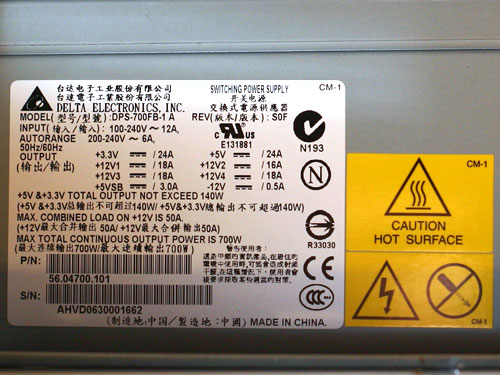 |
| Click to enlarge |
With all of the powerful components present in the system, it's not too surprising to find a large 700W power supply feeding the beast. The power supply is manufactured by Delta Electronics, a brand that is present in many OEM desktop and laptop systems. The quality may or may not be up to the level of some of the enthusiast power supplies, but in testing we did not encounter any difficulties. The PSU has four separate 12V lines, with a combined output not to exceed 50A. Likewise, the total output on the 3.3V and 5V lines is not to exceed 140W. The power supply is rated to handle a continuous load of 700W, however, which is far more than the tested configuration is able to use.
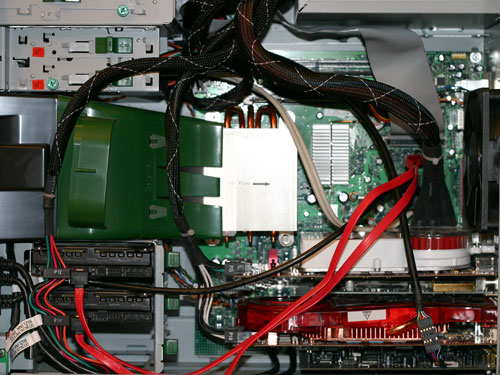 |
| Click to enlarge |
Returning to the GPUs, we have removed the support bars to get a better look. With the two large X1950 graphics cards, the TV tuner, and an X-Fi soundcard, the expansion slot area is fully utilized and somewhat cramped. It's interesting to look at the two X1950 GPUs, specifically their heatsinks, as they appear to be specially designed to fit within the system. The top CrossFire card has a heatsink and fan design that blows inward, which allows it to fit next to the large CPU heatsink. Meanwhile, the bottom X1950 XTX is a standard ATI design that vents out the rear of the case. It's also worth noting that the top GPU occupies two slot widths, but it only takes up a single expansion slot bracket, which as we mentioned earlier is part of the reason why a GeForce 8800 GPU can't fit in the top slot. However, even if there were a second expansion bracket mount open, the size of the heatsink on a GeForce 8800 would preclude it from being used, unless similar to the X1950 CrossFire card it was a special design.
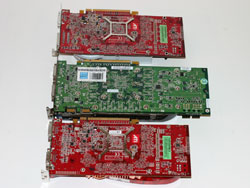 |
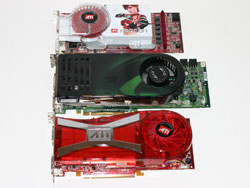 |
| Click to enlarge | |
We took a comparison shot of the two graphics cards alongside an 8800 GTX to give you a better idea of how the CrossFire card has been specifically designed for use in the FX530. You can also see how much larger the 8800 GTX is, and at first we weren't even sure if it would be able to fit within the system at all. With a bit of careful maneuvering, however, we did manage to fit it into the bottom X16 slot. There's not a whole lot of extra room, and the support bars can no longer be used given the location of the PCI-E power connectors. The power supply's PCI-E connectors are also a stretch to get both of them to reach the bottom graphics slot, but we did manage to make it work.
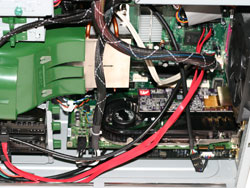 |
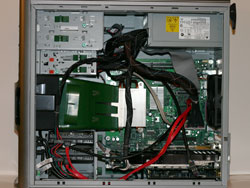 |
| Click to enlarge | |
We will take a look at performance of the Gateway system with the 8800 GTX installed, along with the included X1950 CrossFire solution. In general, however, even though the CrossFire cards are faster in many situations we would prefer to have a single 8800 GTX instead of two X1950 cards in a CrossFire solution. The launch of Windows Vista has only solidified that recommendation, as both CrossFire and SLI are experiencing difficulties with the new WDDM. There have also been numerous instances since the first appearance of SLI and CrossFire where newer gaming titles weren't able to properly utilize both GPUs. Combine that with the fact that a single 8800 GTX cost less than an X1950 CrossFire solution and it includes DirectX 10 support, and out of the gate the FX530 appears to be a design in need of a graphics upgrade, at least if you're really like playing modern 3D games.










26 Comments
View All Comments
akers - Tuesday, March 20, 2007 - link
Can anyone shead some light on why Gateway is delaying shipment on the FX530? I have had two delays so far and they cannot promise that it will be deliered by the second delay date. I have heard that there were so Vista problems but it was fixed by now.rfaster - Thursday, March 22, 2007 - link
My system arrived last week - I ordered it bare bones with the quad core OC'd to the 3.2.Specs - I put in a 8800GTX (fac OC'd to 600) - 2nd slot so its only running at 4X ( I did not realize this until I read the great article on this site), I'm running 2 150 10K raptor's, 4GB 667 ram. The best I can do is low 9K's on 3DMark 2006 (Running Vista Ultimate 32bit). I'm seeing easy 1,200's from other folks with similar setups.
Question - Is the 4X for Slot 2 causing the SLOWNESS? As you pointed out in your article there is NO way to fit the 8800GTX into slot 1 - so I am trying to decide if I should accept the 4X speed on my $699 8800GTXOC - or ship this pc back. I hate to think that my $699 video card is a WASTE on this system due to the 4X?
rfaster - Thursday, March 22, 2007 - link
Akers - on the delay I was told they are having a difficult time sourcing the parts needed to build this system. I was a bit put off by the delay on getting this box -- reminded me of my experience with Alienware a few years back ----JarredWalton - Monday, March 26, 2007 - link
Right now, Vista plus 8800 GTX is probably going to be a bit slower than normal. Still, I wouldn't worry too much - you can see that your low 9000s score matches what I got in 3DMark06... which is really just a benchmark and not an actual game.Darkskypoet - Thursday, February 15, 2007 - link
Now, correct me if I am wrong... But One of the major hinderances to the Quad FX platform (yes I realize 2 dual core chips is power hungry, and inelegant vs a dual die Quad core) is NUMA, rather the lack of proper NUMA support in XP. Looking at the benchmarks (and in fact all Quad FX bench's) sites continue to use XP variants to benchmark the Quad FX systems vs Conroe. XP does not support NUMA, one article in particular I had read mentioned this fact explicitly, and also mentioned that in many cases accessing data in memory in a NUMA dumb system incresed memory latency SUBSTANTIALLY. Consider that in a NUMA dumb O/S, the data required for a process / thread assigned to one chip, could inadvertantly have it's data stored in memory directly linked to the other CPU. This alone hurts benchmarking scores like crazy. In reality a Quad FX setup, if benched with real SMP/ SMC aware software, should eek out a higher per core performance vs Quad Core Conroe, then an X2 vs Dual Core Conroe.I saw this because the interconnect superiority (When run with NUMA Aware O/S : Vista / Linux / Etc.) will show itself vs the somewhat limited FSB in use in Quad Core C2D implementations; thus increasing performance per core vs Quad Core C2D.
I'm not saying we're gonna see the Quad FX Systems out perform C2D systems here. However, given proper NUMA support, the Benches will be a lot closer. Added to that we can use 2xxx series opterons in QUAD FX, and it starts to become a bit of a nicer picture for AMD. The icing on the cake however, would be that one should expect to be able to drop 2 native Quad Cores on to the QUAD FX boards in the near future.
I believe Nintendo Summed it up for us previously, "Now you're playing with power". If AMD follows this track, then they have a platform out that is fully tested, and stable; running 2 NAtive Quad core chips for the Enthusiast market. As unknown as the Performance of K10 is at this stage, 8 cores with should be mighty interesting. Mighty interesting Indeed.
Anyone know of a Proper NUMA aware OS used in Quadcore C2D vs Quad FX benchmarking?
Tuvoc - Saturday, February 17, 2007 - link
Windows XP x64 edition DOES support NUMA. I have dual Opteron 265s (nicely overclocked from 1.8 to 2.2) and as long as the BIOS is set correctly, then Sandra reports the NUMA statusI also have an Intel Quad core, and it is blindingly fast....
roflsaurus - Tuesday, February 13, 2007 - link
BTX case?JarredWalton - Tuesday, February 13, 2007 - link
BTX is a new form factor that Intel came up with a couple years ago, but the computer parts manufacturers have been relatively slow to adopt it. Basically, it reorganizes the locations of various parts in order to allow for better cooling. Motherboards are also mounted on the offices side of the case, compared to ATX. So where you would open the left side of the case on an ATX system, on the BTX case you would open the right side. If you were to put an ATX motherboard and a BTX motherboard next to each other, on the BTX motherboard everything would appear to be "backwards".Tuvoc - Sunday, February 11, 2007 - link
They say Gateway had to increase the voltage to make the overclock stable - but by how much ? That would have been intresting to know. Also core temps under full load certainly would have been very interestingJarredWalton - Monday, February 12, 2007 - link
The motherboard doesn't appear to work all that well at higher FSB speeds, so Gateway's overclocking is accomplished via changing the multiplier. More on this in a moment.Voltages are also a bit odd. CPU-Z reports 1.238V, but the BIOS is set to 1.450V. Obviously, there's a pretty big difference, and which is more accurate I cannot say. That illustrates the problem with reporting CPU temperatures as well: the BIOS/motherboard implementation will have an impact, as they can read the thermistor differently. Basically, you only end up comparing the Gateway results to itself, and the important thing is that there were no issues with stability when running overclocked.
Back to the FSB stuff. The BIOS has support for adjusting FSB speed and RAM speed, but only in large steps. The FSB can be set to 533, 800, 1067, and 1333 - default being 1067 for Core 2. The RAM can be set to DDR2-400, 533, and 667 (or Automatic). Basically, all of these items select a ratio and bus speed. DDR2-533 represents a 1:1 bus/RAM ratio, while 400 is 3:4 and 667 is 5:4. Using those ratios, you can use the FSB-1333 speed to modify the overclocks a bit. I was able to run the bus at 1333 with DDR2-533 and a 10X multiplier to end up at a 3.33 GHz CPU speed (and a real DDR2 speed of 667).
RAM voltages can be adjusted as well, but only to 1.8, 1.9, 2.1, or 2.2V. I didn't play with these at all. No point in trying to fry Gateway's equipment. I would venture to guess that the CPU could run at 3.3-3.5GHz if you want to push things (3.33 seemed perfectly fine in somewhat limited testing), but again I don't want to push too hard and end up with a dead PC/CPU/RAM/mobo/whatever.
Hope that helps,
Jarred Walton
Editor
AnandTech.com